Mastering the art of round cake serving is essential for any celebration, ensuring every guest enjoys a perfectly sized portion. Proper serving enhances both presentation and flavor, while also allowing for efficient portion control and even distribution. Understanding how to choose the right cake size and cutting techniques is crucial for creating a memorable experience. Whether for weddings, parties, or casual gatherings, a well-served round cake elevates any event, making it both visually appealing and satisfying for everyone involved. Start with the basics to ensure your cake stands out and meets your guests’ expectations with precision and style.
Importance of Proper Cake Serving
Proper cake serving ensures even portions, preventing waste and guaranteeing every guest enjoys a fair share. It enhances presentation, making the cake a centerpiece of the event. Correct serving also maintains the cake’s structural integrity, ensuring it remains stable and visually appealing. This attention to detail elevates guest satisfaction and event professionalism.
Overview of Round Cake Sizes
Round cakes come in various sizes, typically ranging from 6-inch to 12-inch diameters. Each size accommodates a different number of servings, making them versatile for events of all scales. Understanding these standard sizes helps in selecting the right cake for your gathering, ensuring ample portions and a visually appealing presentation.
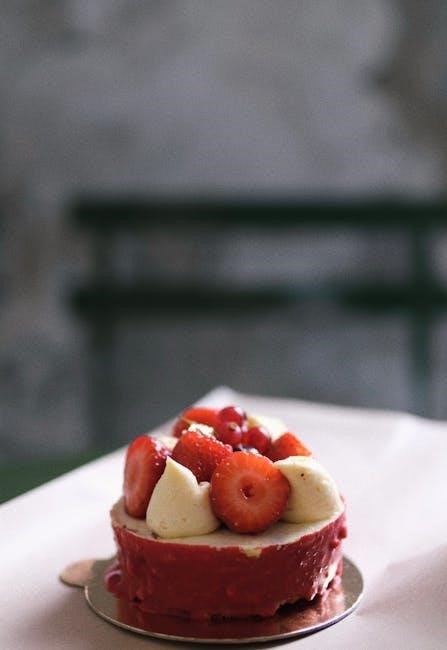
Understanding Cake Sizes and Servings
Round cakes vary in size from 6-inch to 12-inch diameters, each offering a specific number of servings. Understanding this relationship helps in selecting the right cake size for your event, ensuring everyone is served adequately and the cake fits the occasion perfectly;
Standard Round Cake Sizes (6-inch to 12-inch)
Round cakes typically range from 6-inch (serves 6-8 people) to 12-inch (serves 40-50 people). Each size is ideal for different events, with smaller cakes suited for intimate gatherings and larger ones for big celebrations. Understanding these sizes helps in planning and ensuring there’s enough cake for everyone at your event.
Number of Servings per Cake Size
A 6-inch round cake serves 6-8 people, while an 8-inch serves 12-15. A 10-inch cake serves 20-25, and a 12-inch serves 40-50. These estimates vary based on portion sizes and cutting styles, helping planners determine the ideal cake size for their event. Using a cake serving chart ensures accuracy and avoids waste.
How to Determine the Right Cake Size for Your Event
Assess the number of guests and the serving style to choose the right cake size. Consider portion sizes and event type, as weddings may require smaller slices than casual gatherings. Use a cake serving chart to match guest count to cake diameter, ensuring everyone is served adequately without excess or shortage.
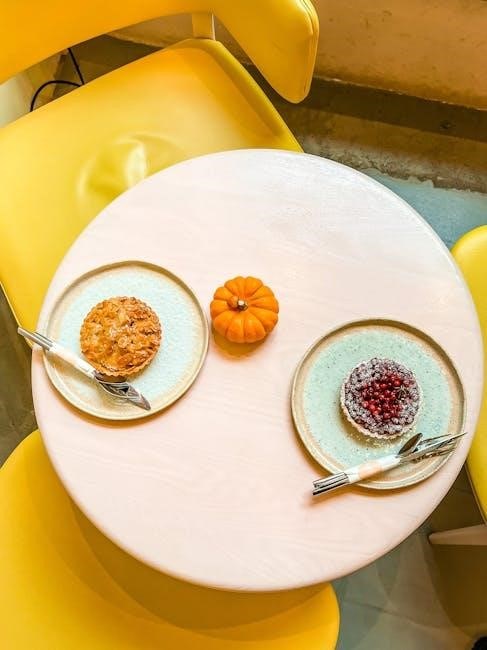
Portion Control and Cutting Guide
Master portion control with precise cutting techniques, ensuring even slices. Use tools like serrated knives and serving guides to achieve consistent sizes, enhancing both presentation and guest satisfaction.
Party Cut vs. Wedding Cut: What’s the Difference?
A party cut typically involves larger, fewer slices, ideal for casual gatherings, while a wedding cut yields smaller, more precise portions, perfect for formal events. Both methods ensure even distribution, but the wedding cut offers a more elegant presentation and greater control over serving sizes for large crowds.
How to Achieve Even Portions
To achieve even portions, use a serrated knife and cut in a straight, consistent manner. Start by leveling the cake, then mark portion lines with toothpicks or a knife tip. Cut in a grid pattern for uniform slices. For precise results, use a cake serving chart or measuring guide to ensure fairness and consistency.
Using a Cake Serving Chart for Accuracy
A cake serving chart is a valuable tool for ensuring accuracy when portioning. It provides clear guidelines on the number of servings per cake size and helps determine the right amount of batter needed. By using a chart, you can avoid over- or under-serving, ensuring every guest gets an equal slice. Use toothpicks or markers to guide your cuts and achieve uniform portions effortlessly. This method guarantees consistency and fairness, making it especially useful for large events or tiered cakes. A serving chart simplifies the process, allowing you to focus on presentation and enjoyment. It’s a must-have for any baker or host aiming for precision and satisfaction.
Tools You’ll Need for Serving Round Cakes
Essential tools include serrated knives, serving spatulas, cake stands, and cake boards. A cake leveler ensures even layers, while turntables and serving utensils enhance presentation and efficiency.
Essential Tools: Knives, Cake Stands, and Serving Spatulas
A long serrated knife is vital for even cutting, while a cake stand or turntable enhances presentation. Serving spatulas help portion slices neatly, and cake boards provide stability. These tools ensure precise cutting, seamless serving, and an attractive display, making the process efficient and visually appealing for any event or gathering.
How to Use a Cake Leveler for Even Layers
Place the cake on a cake board and position the leveler on top. Adjust the leveler to ensure evenness, then gently remove excess cake or frosting. This ensures uniform layers, preventing wobbling and promoting a clean, professional finish. It’s especially useful for tiered cakes and multi-layered designs.
The Role of a Cake Board in Serving
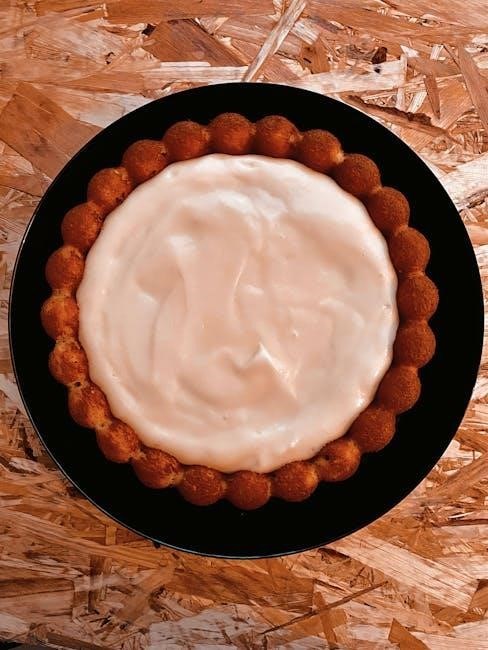
A cake board provides stability and protection for the cake during transport and serving. It prevents the cake from shifting or damaging, ensuring a clean presentation. Choose a board slightly larger than the cake to allow easy handling. This essential tool enhances both safety and professionalism for any event.
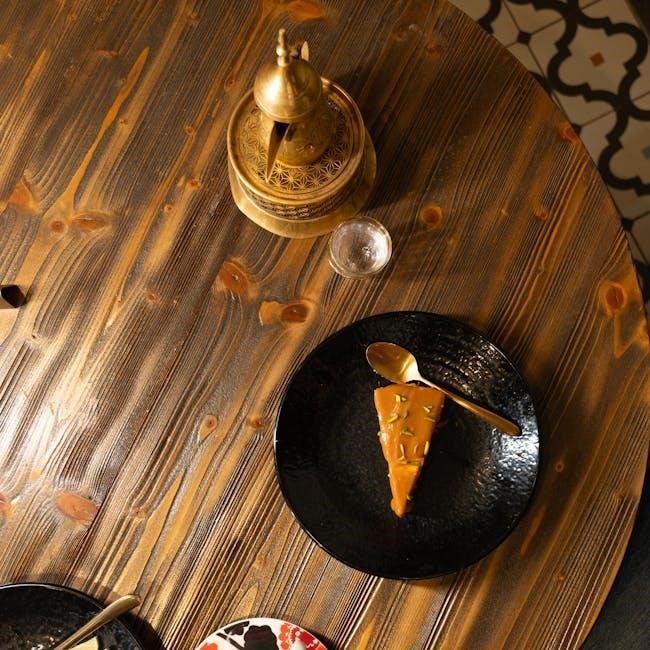
Tips for Leveling and Frosting
Use a serrated knife to level the cake evenly. Apply a thin crumb coat first, then frost smoothly. Chill between layers for a polished finish.
How to Level a Round Cake Like a Pro
Place the cake on a turntable for stability. Use a long serrated knife to slice off the dome, ensuring an even surface. Mark the cake’s height with toothpicks on opposite sides as a guide. For precision, use a cake leveler or serrated knife to achieve a perfectly flat top. Freeze the cake briefly for easier handling, and ensure your knife is sharp to avoid tearing the cake. This method guarantees a smooth, professional finish for frosting and decorating.
Applying the Perfect Crumb Coat
Apply a thin, even layer of ganache or buttercream to the cake, spreading it with an offset spatula. Ensure full coverage, including the sides, to trap crumbs. Freeze for 10 minutes to set, creating a smooth base for final frosting. This step prevents crumbs from marring the finish, ensuring a polished look.
Frosting Techniques for a Smooth Finish
Apply a crumb coat, chill, then frost with smooth, even strokes using an offset spatula. Rotate the cake on a turntable for consistency. Work in small sections, blending edges seamlessly. Remove excess frosting for a polished look. This method ensures a professional, smooth finish for your round cake.
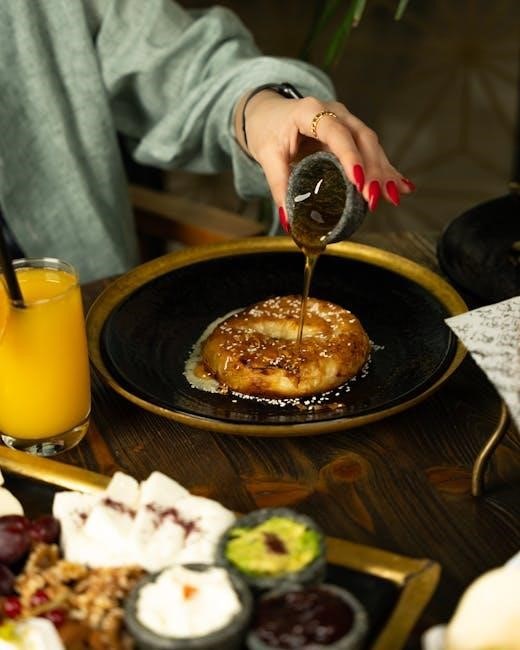
Decorating Your Round Cake for Serving
Elevate your round cake with fresh flowers, elegant piping, or simple designs. Use vibrant colors and patterns to match your event theme for a stunning presentation.
Simple Decorations for Everyday Serving
Add elegance with minimal effort using fresh flowers, simple piping, or a light dusting of powdered sugar. Classic designs like borders or a centered message create a polished look. These decorations are perfect for casual gatherings, ensuring your cake looks inviting without needing intricate designs or advanced techniques.
Elaborate Designs for Special Occasions
Elevate your round cake with intricate designs for weddings, anniversaries, or milestone events. Tiered cakes, fondant detailing, and sugar flowers create a stunning centerpiece. Intricate piping, hand-painted designs, or edible metallic accents add sophistication. These designs not only impress visually but also reflect the occasion’s theme, making the cake a memorable focal point of the celebration.
Using Fresh Flowers or Edible Decorations
Fresh flowers like roses, orchids, or lavender add elegance and fragrance to your round cake. Edible decorations such as berries, chocolate shavings, or candy provide vibrant colors and textures. Ensure flowers are non-toxic and placed safely to avoid contamination. This method enhances visual appeal while maintaining the cake’s flavor and freshness for guests.
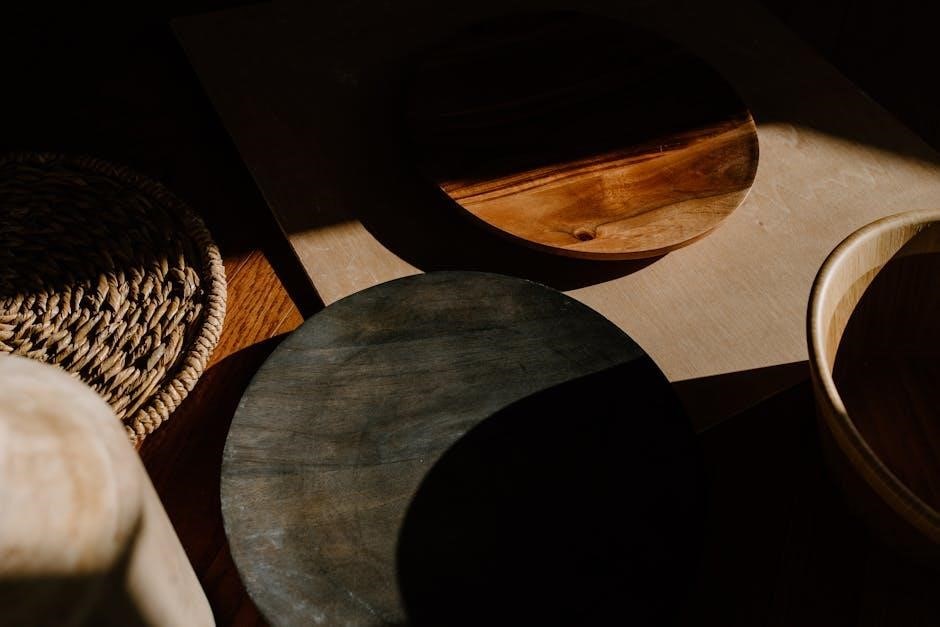
Serving Safety and Hygiene
Proper handling and storage prevent contamination, while hygiene practices during cutting ensure safety. Clean tools and gloves are essential. Store leftovers in airtight containers to maintain freshness and prevent spoilage.
Handling and Storing the Cake Before Serving
Properly handling and storing a round cake ensures freshness and safety. Wrap the cake tightly in plastic wrap or aluminum foil and refrigerate for up to 3-5 days. For longer storage, freeze up to 3 months. Always bring the cake to room temperature before serving for optimal flavor and texture.
Hygiene Practices When Cutting and Serving
Ensure all utensils, such as knives and spatulas, are clean and sanitized before cutting. Wash hands thoroughly with soap and water. Prevent cross-contamination by using separate tools for cutting and serving. Clean the serving area and cake stand before placing the cake. Always use a cake board to protect the cake from contamination.
How to Keep the Cake Fresh After Serving
Store leftover cake in an airtight container or wrap tightly in plastic wrap or aluminum foil. Keep it in the refrigerator for up to 5 days or freeze for up to 3 months. Let the cake come to room temperature before serving for optimal flavor and texture. Check for freshness before storing.
Creative Serving Ideas
Elevate your round cake presentation with unique displays like tiered stands or themed setups. Pair cakes with complementary desserts for variety, creating a visually appealing and delicious spread that captivates guests and enhances the celebration’s ambiance.
Unique Ways to Present Your Round Cake
Add elegance with tiered stands or themed setups. Use fresh flowers, edible decorations, or creative frosting designs for visual appeal. Pair the cake with complementary desserts or place it on a decorative cake board to create a stunning centerpiece that enhances the event’s ambiance and draws admiration from guests.
Pairing Cakes with Other Desserts
Complement your round cake with mini pastries, fruit tartlets, or chocolate-dipped strawberries for a diverse dessert spread. This pairing enhances flavor variety and texture, catering to different preferences. Balancing rich cake slices with lighter options ensures a well-rounded experience, making your event’s dessert selection both satisfying and visually appealing for guests.
Themed Serving Ideas for Parties
Create memorable experiences by tailoring your round cake to match party themes. Use tropical fruits for a luau, edible glitter for a glam event, or seasonal decorations like pumpkins for fall gatherings. Coordinate cake stands, servingware, and toppings with the theme to enhance visual appeal and guest engagement, making the cake a stunning centerpiece.
Common Mistakes to Avoid
Avoid overcrowding the cake plate, as it can make slicing uneven. Incorrect cutting techniques may lead to uneven portions. Not allowing the cake to set before serving can cause it to crumble or fall apart, ensuring a messy presentation and disappointed guests.
Overcrowding the Cake Plate
Overcrowding the cake plate can lead to uneven slicing and messy portions. Ensure the plate size matches the cake dimensions to prevent overcrowding. Cutting the cake before arranging on the plate ensures neat, even servings and enhances presentation. This avoids a chaotic look and ensures each guest gets a perfect slice, making the serving process smoother and more enjoyable.
Incorrect Cutting Techniques
Incorrect cutting techniques can lead to uneven portions and a messy presentation. Always use a serrated knife and cut straight across the cake. Avoid applying too much pressure, as this can cause the cake to break. Cutting on a cake stand ensures stability and even slicing. Using a serving chart helps maintain consistency and fairness in portion sizes, ensuring every guest enjoys an equal share. Proper technique prevents waste and enhances the overall serving experience.
Not Allowing the Cake to Set Before Serving
Not allowing the cake to set before serving can lead to instability and crumbling. Always let the cake cool and set after baking and frosting. Refrigerate for at least 30 minutes to ensure it holds its shape. A set cake is easier to slice evenly and serves cleanly without falling apart.
Special Considerations
For outdoor events, protect the cake from heat and humidity. Tiered cakes require sturdy supports. When serving large crowds, prepare extra serving tools and staff for efficiency.
Serving Cakes at Outdoor Events
When serving round cakes outdoors, ensure stability by using a sturdy cake board. Keep the cake in shade to prevent melting and maintain freshness. Use coolers with ice packs if necessary. Always practice proper hygiene, and consider serving smaller portions to avoid waste. Have backup serving tools and supplies handy.
Handling Tiered Round Cakes
For tiered round cakes, stabilize each layer with dowels or cake boards. Ensure even stacking and smooth frosting between tiers for a seamless look. Use a turntable to display the cake evenly. Always handle tiers with care to avoid toppling, and consider assembling on-site for outdoor events to maintain balance and safety.
Serving Cakes to Large Crowds
Serving round cakes to large crowds requires strategic planning to ensure every guest enjoys a fair portion. Opt for larger cake sizes or multiple tiered cakes to accommodate the number of attendees. Use a cake serving chart to determine optimal portion sizes and ensure efficient cutting. Maintain hygiene standards by using clean utensils and pre-cutting slices for quick distribution. Assign a team to manage the serving process, ensuring timely and organized service. This approach guarantees a seamless and enjoyable experience for all guests at the event.
Frequently Asked Questions
Common questions include determining the right cake size for events, whether rectangular pans can replace round ones, and tips for safe transportation. Answers often involve using portion guides, sticking to round pans for even baking, and securing cakes during transit for freshness and presentation.
How Many People Can a Round Cake Serve?
A round cake can serve 8-30 people, depending on size and cut type. An 8-inch cake serves 8-12, a 10-inch serves 20-25, and a 12-inch serves 25-30. Party cuts yield smaller portions, while wedding cuts provide larger slices, impacting the total servings based on event needs and preferences.
Can I Serve a Round Cake in a Rectangular Pan?
Yes, you can serve a round cake in a rectangular pan, but it may affect presentation. Ensure the cake fits snugly to maintain even portion control and distribution. This method works well for casual gatherings, allowing flexibility in serving while preserving the cake’s integrity and flavor, regardless of the pan shape used.
How Do I Transport a Round Cake Safely?
To transport a round cake safely, place it in a sturdy, flat box specifically designed for cakes. Keep it away from direct heat sources and ensure it’s secure to prevent movement. Drive smoothly, avoiding sudden stops or sharp turns. Once at your destination, refrigerate if needed to maintain freshness and structure.